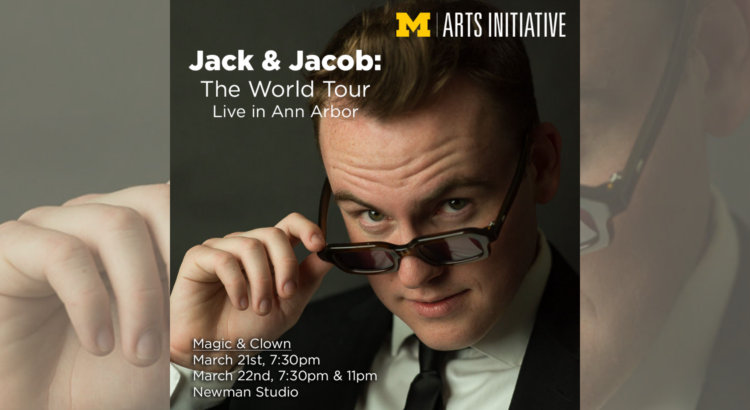The art of clowning may be funny, but it’s no joke.
On Friday night, I had the pleasure of attending Jack and Jacob: The World Tour in the Walgreen Drama Center’s Newman Studio. This piece, part magic show, part clown show, was all entertaining. Conceived by Professor Malcolm Tulip and senior acting major Jack Weaver, this one-hour laugh fest follows the journey of professional performer Jack as he grapples with the abandonment of his partner, Jacob, on the last leg of their comedy-magic fusion world tour.
The performance itself was led by Weaver, who played a heightened, fictionalized version of himself. The show also featured the voice and stage talents of Priscilla Lindsay, Mark Colson, Malcolm Tulip, Hugh Finnigan, Caitlyn Bogart, Amilia Fontaine, Ella Lewis, and Tate Zeleznik. The ensemble was delightful, and Weaver’s performance was nothing short of wonderful. He possesses a unique sense of humor with exceptional improvisational and audience interaction skills, and it was clear that this performer was in his element, utilizing the training he has received both in and out of the classroom over the past four years.
I was immersed in this highly interactive, comical experience before even entering the performance space. Upon arrival at the Newman Studio, audience members were stopped by a bouncer who demanded they reveal personal information about Weaver before answering. After a sufficiently comical interaction, the bouncer ultimately allowed the audience members to enter the performance area. I looked behind me as I entered the darkened space and saw the same routine being repeated with the group entering behind me, giving me the sense that we were all in for the same experience. The highly interactive nature of the bouncer’s greeting continued throughout the performance itself, which begs the question of when the performance began in the first place – a truly engaging and exciting way to spend my Friday night that kept me locked into the performance from the moment I entered the building. Throughout the show itself, audience members were consulted, questioned, spoken to, and even pulled up onstage.
The fictional conflict of the show, the abandonment of Jacob, created a clear arc for the fictionalized Weaver, who subsequently attempted to run the show himself and take on the role of Jacob when needed. It provided the perfect level of storytelling that sparked a sense of empathy in the audience towards Weaver while still allowing us to enjoy the spectacle and physical comedy of the performance itself.
It’s performances like these that remind me of the power that live theatre can have. At Jack and Jacob, I truly felt in community with the audience and actors alike. This production was conceived as a part of an independent study housed in the Department of Theatre & Drama, which only excites me for future projects that have the potential to be created and produced as an academic escapade. In the future, I would love to see more performances that could strike audiences as a more untraditional theatre-going experience, such as Jack and Jacob. Weaver’s passion for clowning, magic, and comedy shone through during this production, and I sincerely hope that other arts students will feel inspired to bring their creative minds to life onstage in a similar way.


